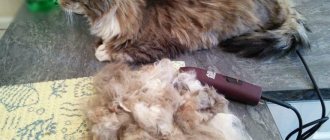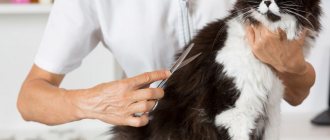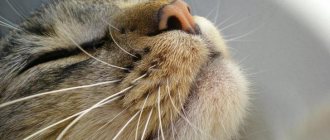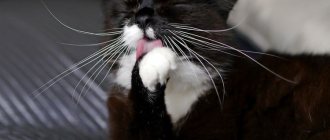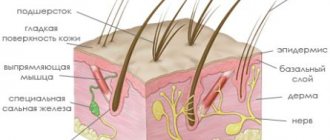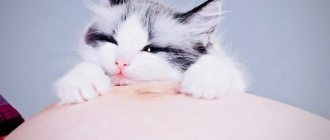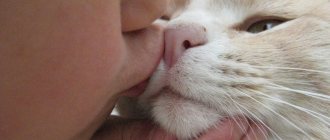Pet hygiene is one of the essential procedures. It is not enough to simply feed and pay attention to your cat. And if cutting nails or bathing are necessary procedures, then grooming is a separate issue. Currently, there are fierce debates not only among owners, but also among professional breeders regarding this procedure.
Opinions vary radically. Some claim that this is dangerous and nature will take care of them itself, for example, seasonal molting. Others are convinced that the aesthetic side of the issue is extremely important. Especially for pets who participate in exhibitions. So, if you cut a cat's hair, how long will it grow?
Let's consider the issue from the point of view of hygiene and aesthetics. Let's try to find a middle ground. Let's answer the question, what are the dangers of frequent haircuts? Looking ahead, it should be noted that the truth lies somewhere between two opposing opinions.
How to speed up the process
A cat's fur, like that of any other animal, goes through 3 stages of growth:
Hair reaches a certain length. Then its development stops and, after a certain time, the hair falls out, giving way to a new one. The cut pile is mainly in a catagen state. An exception would be a haircut to zero, when the developing hairs are also cut off.
Most of the fur coat will not grow back. Fresh anagen hairs will form a new coat after the cat is groomed. How quickly wool grows depends on a number of factors:
- Diet. To speed up the restoration of “hair”, your pet needs proteins. Experts recommend that their share per dry weight be at least 30%. Hair growth is also stimulated by zinc, vitamins and fatty acids. The cat can receive them with food (meat, cooked yolk, sea fish) or nutritional supplements.
Ambient conditions. In nature, animals grow overgrown before frost and molt with the arrival of warmer weather. Cats living in the house are less affected by this cycle, but the connection remains. Wool grows faster in spring and summer. In winter, the process of hair change slows down. By deciding to cut your pet's hair during the warm season, the owner will quickly see his original fur coat. This is a practical solution - animals shed less during the cold season.
Care. Regular combing stimulates hair change. It is also necessary to monitor your pet's stress level. A nervous cat may shed a lot. In this case, new follicles are not activated. If the source of stress persists, the coat thins, even to the appearance of bald patches.
The fur has grown back faster, you need to provide the cat with proper nutrition. You should not imitate warming - too high a room temperature will cause molting, but will not awaken the follicles.
Overheating will also negatively affect the health of your pet and other residents. It is better to cut it in the warm season, with natural accelerated hair change. Although, during the cold season, the hairstyle will last longer.
Causes of delayed hair growth
If after 3-4 months the cat’s fur does not grow after being cut, it is worth showing him to the veterinarian. It is possible that the follicles have not entered the anagen phase. But there are other reasons:
- bacterial and parasitic infections - waste products of pathogens poison the body, affecting various organs, including the skin;
hormonal disorders - hair growth can be hampered by malfunctions of the adrenal glands, changes after sterilization, ovarian tumors and other conditions;
weakening of the body due to illness or stress.
Thus, the hair on the area shaved for surgery (examination) may grow back more slowly than with a regular haircut. The age of the pet is also taken into account. The tissues of older cats recover more slowly compared to young cats.
Delayed hair growth can be observed in females during pregnancy or nursing offspring - the body is focused on other tasks.
Is it worth getting a haircut?
A pressing question, given the role of fur in a pet’s daily life. She helps:
- protect the body from mechanical injuries and ultraviolet radiation;
maintain normal temperature in cold and warm environments;
assess the environment - the villi are not as sensitive as the whiskers (whiskers), but they are also involved in tactile perception;
communicate - by fluffing up its fur coat, the cat tries to visually increase in size in order to influence the enemy.
Grooming can deprive your pet of its protective layer and cause severe stress. This problem arose in a four-year-old cat named Ollie from a small British town. The Mirror published his story in the summer of 2015.
The animal was cut to zero - the hairdressers stated that such a measure was required due to the abundance of tangles. According to the owner, after the procedure the cat was depressed, did not want to leave the room and obsessively demanded people's attention. The dogs living in the house also stopped recognizing him.
This is a rare case, but it shows the possible consequences of a seemingly harmless procedure. You shouldn't cut your cat's hair for no reason. If you decide to go to a hairdresser, you should not treat:
tail - partial cutting is allowed, but the upper half (third) is left untouched.
Experts recommend avoiding cutting your hair to zero. Western sources advise leaving the coat 1 inch long if the owner is struggling with shedding and excess hair in the home. Considering that in many breeds the pile does not exceed 2.5 cm, you can stop at 0.5-1 cm. This way a person will get rid of hair indoors, and the cat will retain a protective and heat-insulating layer.
Having shaved the pet almost bald, the owner should put cotton capes on it to prevent direct sunlight on the skin. Without this measure, the risk of burns or cancer increases.
In particular, prolonged sun exposure promotes the development of basal cell and squamous cell carcinomas, which affect the upper layers of the skin.
You also need to monitor the cat’s communication with other animals in the house. Lack of fur increases the risk of injury during play and fighting.
How quickly a cat grows after a haircut depends on a number of factors. On average, the process takes six months. It can be accelerated by using a diet rich in proteins, vitamins (in particular group B) and microelements.
A haircut during the warm season will also help – hair grows more actively in spring and summer. If your cat's coat does not grow back for a long time, or bald spots, reddened areas or damage appear on the skin, you need to contact a specialist.
This could be the consequences of licking (the animal is not accustomed to the new length of the fur coat), injury or signs of illness.
Have you thought about cutting your pet's hair? Write about it in the comments.
Source
Treatment
If your cat's fur is falling out a little more than usual, but its general condition has not changed, there is no need to sound the alarm. First of all, analyze the external changes in the keeping of your pet:
- buying new food;
- vaccinations and medications;
- using air fresheners and other chemicals at home;
- stressful situations.
Often a course of vitamin supplements stops hair loss. If, after eliminating the irritating factors, the fur continues to fall out intensively for several weeks or months, it is recommended to consult a veterinarian.
Another tactic if you suspect a contagious skin disease (mites, lichen, demodicosis). In such cases, a skin scraping or biopsy is required. Depending on the identified parasite, antifungal agents are prescribed (for lichen, Griseofulvin, Intaconazole), antiseborrheic shampoos and antiseptic solutions for treating festering wounds and scratches. In case of severe itching, it is advisable to put a cone on your pet. Severe bacterial infections require the use of antibiotics (Amoxicillin, Baytril, Kanamycin). At the same time, multivitamin preparations and immunostimulants (Immunol, Gamavit, Maksidin) are prescribed. Genetic diseases - hypotrichosis and alopecia - cannot be cured. Love your pet with all its features.
Important! The use of medicinal “human” drugs to treat cats is strictly prohibited. Even Paracetamol, which is safe for humans, can cause serious complications in pets. Treatment of cat diseases involves special dosages and medications that can only be prescribed by a veterinarian.
Don’t forget about deworming your pets. Anthelmintics are used:
- 2 weeks before vaccination - minimize the risk of adverse consequences;
- pregnant cats in the last third of pregnancy - prevent intrauterine infection of kittens with worms;
- in case of total infestation, kittens picked up on the street often vomit with worms.
An antihelminthic course (Prazicide, Dirofen, etc.) includes two doses of drugs (tablets, suspensions) with an interval of 10-14 days. The best remedies are Milbemax and Profender - they destroy both adult parasites and their eggs in a single dose.
How long does it take for a cat's fur to grow?
my sister saw a photo of a cat with a lion haircut and cut our cat’s hair, but it was unsuccessful, how long will the fur take to grow back?
Cats' fur grows continuously, falling out and being renewed from time to time. The hair growth cycle consists of an active growth stage, a transition period and a final phase. They grow at a rate of 1/4 to 1/2 cm per week, hair length increases by about 8 mm each month, and seasonal hair loss in cats is more associated with changes in day length than temperature fluctuations. Domestic and wild cats shed differently. So, in nature, wild cats shed only once a year. The seasonality of molting is primarily determined by changes in the length of daylight hours. Domestic cats living in artificial light and warmth shed all year round. In females, shedding occurs after estrus, during pregnancy or after feeding kittens. Cats have sparse hair between their ears and eyes, and this natural baldness becomes more noticeable during the shedding season. The fur of domestic cats is renewed almost throughout the year. Many breeds, especially short-haired ones, change it quite quickly and even unnoticeably. In long-haired animals, shedding lasts longer - as a rule, from September to November and from February to April (each animal has its own way). Most cats have an undercoat. Their coat consists of a long outer coat and an undercoat - soft, short hair. When such a cat begins to shed, its appearance becomes unpresentable and suggests a skin disease. This is because the undercoat sheds in patches and patches, making the coat appear moth-eaten, but this is completely natural. Cats do not shed evenly or in waves. Combing and smoothing the fur with a brush during these periods is necessary daily and is extremely necessary, since this removes dead and unremoved hair, which irritates the skin, provoking the cycle of “itching - scratching - itching” and skin damage, which, in turn, leads to various complications . Also, when combing, the skin is massaged and the growth of new hair is stimulated. The more wool you comb out, the less it will be licked, swallowed and the less there will be in the apartment. In addition, it reduces the likelihood of hair balls (bezoars) forming in the stomach. The first moult, when the kitten's uncolored hairs are replaced by the coat of an adult animal, occurs in the 5-7th month, in autumn or spring. It starts from the head. It is there that the wool first acquires a stable color. Replacement of hair on the torso sometimes takes a year or more.
Source
Situations in the wild when cats deliberately deprive their relatives of their whiskers
As it became clear, whiskers are an important sensory organ; naturally, whiskers are well aware of this, so in nature there are situations when cats deliberately pull out the whiskers of their relatives. First of all, we are talking about a fight, then rivals may try to deprive each other of their mustaches precisely because they are so important. Their loss automatically means the cat is weak and becomes more vulnerable. In disputes over territory in the wild, this situation is not uncommon.
Science also knows of cases where a mother cat chewed off the whiskers of her children. This was due to the fact that she did not want the babies to leave the makeshift “nest” prematurely. A kitten whose ability to navigate due to deformation of its whiskers was weakened more often remained near its mother, because It’s warm around her and, most importantly, safe. New vibrissae grew within six months. And all this time the kitten was forced to stay near the parent. Despite the fact that the mother cat had good intentions in such situations, such behavior still has more of a negative impact than a positive one.
It is forbidden to trim the whiskers of cats (or cats), this action is akin to depriving a person of one of his senses. Whiskers play an important role in a cat's life and their loss can lead to sad consequences, the severity of which varies from being in a bad mood to losing orientation in space.
Archibald
The nuances of the appearance of hair in cats after a haircut
Quite often, owners of felines notice that the cat’s hair does not grow for a long time after a haircut. We propose to analyze why this happens and what to do about it.
How the problem manifests itself
Of course, owners are concerned about why problems may arise with restoring the coat and how quickly the cat will grow back after a haircut. If the “fur coat” is not renewed for more than 6 months, the animal has alopecia – delayed fur growth. It is determined by the following criteria:
- The cover grows partially, in different parts of the body.
- A month after the procedure, the “fur coat” looks as if it was cut yesterday.
- In places where there is no fur, redness appears.
Before you start worrying, ask your groomer a question: how long does it take to groom a cat? As a rule, professionals note that after 4 weeks the cover begins to gradually renew, but in general the haircut will remain visible for another six months.
What are the reasons for slow growth
Considering how quickly cats grow overgrown after a haircut, the reasons for prolonged recovery are the following:
- Hormonal imbalance, more often observed in cats than cats. The problem arises due to the lack of offspring.
- Heredity. If the kitten's parents are susceptible to baldness, then alopecia will overtake the offspring.
- Nutrition. A cat's fur may not grow after a haircut due to problems with nutrition. Perhaps your pet is not eating regularly or the body is not getting enough nutrients.
In any case, it is recommended to show your pet to a veterinarian.
How long does a cat's hair grow after a haircut?
Masters, as well as furry owners, note that the procedure should be carried out twice a year. At the same time, it is important to understand how long a cat’s haircut in its original form will last. Typically, an ideal “hairstyle” lasts no longer than two months.
Source
Cat grooming at home
If you decide to shave an animal, then for the procedure you will need:
hair clipper with one or more attachments;
scissors with rounded ends; comb;
hydrogen peroxide (if you accidentally injure your pet).
You will also need an assistant who will hold the cat trying to escape. If the animal is very active, you will have to give it a sedative.
Start trimming your cat from the sides, then proceed to the back.
Next is the abdominal area. Here you should act especially carefully so as not to injure the mammary glands and genitals.
Then the hair in the armpits, around the anus and on the hind legs is trimmed.
You don't have to touch the tail at all. If you decide to tidy it up, be sure to make a tassel at the end: the cat will chew the bare tip of the tail.
Please note: you cannot cut the hair on the head, ears, or whiskers.
Turn on the machine at some distance from the animal to scare it less. The nozzle should leave a fur length of at least three millimeters. You can cut the wool both in the direction of growth and against it. The second option slightly increases the cat’s discomfort, but allows you to complete the procedure faster: in this way, a larger amount of hair is removed at a time. Be sure to stretch your pet's skin in the area where the machine passes. Cut off missing hairs with scissors.
Upon completion of the haircut, thoroughly comb your pet with a slicker brush and wipe with a damp towel. This way you will remove all the cut hair so that the cat does not lick it later.
Grooming a cat is not an easy procedure. If you are not sure that you can handle it on your own, or your furry pet needs to be groomed for an exhibition, it is better to contact a professional groomer.
AGE OF THE KITTEN AND ITS CHARACTERISTICS
The development of kittens occurs quite intensively in the first months of life; their structure and nutrition undergo many changes. And this time of growth of a kitten is considered the most important in its development and formation, so you need to do everything correctly and, most importantly, on time!
The article contains a lot of useful information: up to what age does the growth of a cat and the growth of cats continue, the size of the cat and what size the cat will be in each month of its life, the development of a kitten by month: stages of kitten development (kitten development calendar), the growth of kittens by week, weight kittens by month, the behavior of kittens in each period of development, how to raise a kitten so that it grows up social, when kittens open their eyes and much, much more.
The development of a cat and the development of a cat are slightly different; a cat does not gain weight as rapidly, however, as a rule, cats are more curious and active than males. But in general, everything happens at the same time, without serious lags on both sides. The development and growth of kittens by month in the table will help determine the age of your pet!
UNTIL WHAT AGE WILL KITTENS REMAIN BABIES? HOW MANY MONTHS WILL THE KITTEN BE A KITTEN?
Determining the age of a kitten: if you want to determine the age of a kitten based on external data and characteristics, carefully study the table and find the characteristics that match your pet. Determining how many months a kitten is is quite simple, because a kitten changes a lot every month. Here are the characteristics that you should pay attention to to find out how many months a kitten is: weight and size of kittens by month, teeth (baby, permanent, or during the period of teeth change), fur and undercoat, eye color, behavior. So how do you find out the age of a kitten? Read the description in the table and compare!
Also, how to find out how many months a kitten is and how to determine the age of a kitten will be helped by a photo.
Tips for owners
Experienced groomers and breeders recommend that owners who decide to groom their pet on their own:
- Do not touch the tail during the procedure.
- It is especially gentle and careful to cut the fur on the belly; this is the most vulnerable place for cats; in addition, there are many folds that an inexperienced person can easily snag with scissors or a clipper.
- Psychologically prepare the cat. It is better to accustom him to the sight of scissors, a trimmer, and a grooming table from an early age.
- You should regularly, long before the first haircut, place the cat on the table and gently comb it. In this case, she will not be afraid of this place and will calmly endure the procedure.
- It is advisable to use a silent device with low vibration levels.
- It is necessary to carry out the haircut in two or three stages, giving the pet time to rest, and always talk to him affectionately during the process.
- Never touch the mustache, eyebrows, ear hairs and hair on the head. The muzzle is cut only by experienced groomers when creating model hairstyles. Vibrissae are vital for animals to orient themselves in space.
- Never cut cats bald.
- If it is possible to carry out care without cutting, it is better to refuse it.
SEE THE STAGES OF KITTEN DEVELOPMENT IN THE KITTEN GROWTH TABLE
Let's consider all stages of development of kittens from birth to one year, their characteristics of maturation and growth, features of care at each age.
A newborn kitten is born weighing 80-120 grams, the size of kittens at birth is body length about 9-12 cm.
Very rarely, but still there are cases of the birth of kittens 50-70g, they are small but active. This does not always serve as a signal that the kitten is sick or has abnormalities. This also occurs in multiple pregnancies or in the case of small parents.
Newborn kittens: photo of the litter Newborn kittens are absolutely helpless during this period, they are blind, deaf, and do not know how to regulate their temperature. Newborn kittens have no undercoat; the fur is thin, weak and does not warm at all.
Newborn British kittens Kittens do not know how to stand on their paws, their bones are very fragile, so babies require special care. At this time, sleep and kittens are almost inseparable concepts. Newborn kittens sleep almost constantly and eat a lot and often. Kittens need sleep for the further development of their nervous system. Newborn kittens also cannot defecate on their own; the mother cat licks their genitals and eats their feces. What is really well developed in newborn kittens is their sense of smell and touch; they easily find their mother’s nipples, fingering them with their paws, sucking and, thereby, stimulating further milk production.
Newborn kittens: photo of the litter During this period, it is better not to touch the kittens at all, just monitor their weight. Kittens should add it daily (about 10-20 grams per day), if the kitten is growing, then everything is in order.
Things to take care of:
- Set up a box for a cat (or organize a maternity house) with newborn kittens. It should be warm and dry there. The bedding should be changed (it is advisable to use white sheets to track the color of the mother cat’s discharge), because The cat will have postpartum discharge. Also, if necessary, you can put a heating pad.
- Cat food. It should be plentiful and balanced; food is a must for nursing cats. Food and water should be freely available, next to the nest box. It is also recommended to place a tray here.
Cats are by nature excellent mothers and may not leave the box for a whole week, so it is important that newborn kittens have enough milk. In the first days, the cat produces colostrum (very fatty, nutritious milk that has antibodies, thanks to which kittens develop lasting immunity).
If there are a lot of kittens, be sure to make sure that each newborn kitten gets its good portion.
The development of kittens after birth (the development of newborn kittens) is very active, so the first week can be planned out day by day.
KITTENS – DEVELOPMENT BY DAY:
1-2 days after birth, a newborn kitten only sucks milk and sleeps.
After 3-4 days, the kitten’s umbilical cord heals and falls off.
After 4-5 days , the kitten’s hearing begins to develop, and you can already observe how it begins to react to loud sounds.
HOW LONG DO KITTENS SLEEP? WHY DOES A KITTEN SLEEP ALL DAY?
If it seems to you that the kitten sleeps all the time, this is most likely normal, and there is no need to worry right away. In the first week, the kitten sleeps about 22 hours a day. Just weigh the kitten daily - this is the best indicator that everything is fine with the baby.
A newborn kitten sleeps up to 22 hours a day. How much a kitten should sleep, he decides for himself, however, if the kitten sleeps constantly and does not gain weight, first of all, pay attention to whether the kitten has enough free nipple (this happens more often if there are 5 or more kittens in a litter) , if the kitten is weak or the last born, apply it to the cat more often and do not let other kittens chase it away. If in this case the kitten behaves sluggishly and does not recover, contact your veterinarian. Kittens from birth to one month change greatly both in appearance and development, and it is important to pay close attention to this in each period. Newborn kittens in the photo, look in the pictures.
The weight of a kitten at 1 week is 170-280 g. Week-old kittens are already starting to move more. By the end of the first week, kittens' ears open up, allowing them to hear better.
Also in the first week, you can see signs of long hair - small curls appear behind the ears.
Kitten aged 1 week
WHEN DO KITTENS HAVE EYES?
Also, by the end of the first week, the kittens' eyes begin to appear.
When do kittens' eyes open completely? How long does it take for kittens to open their eyes after birth?
Kitten 1 week:
- paws become stronger;
- the kitten sleeps a little less;
- the fur begins to “fluff”;
- the first undercoat begins to emerge;
- the kitten crawls and easily crawls towards the mother 30-50 cm;
The kittens are already a week old, and you are probably already thinking about names for them. Choose names for kittens boys and girls from “A” to “Z” here
Kittens at 2 weeks not only crawl, but also begin to walk, although they do it very unsteadily; kittens at 2 weeks behave more actively, releasing their claws more and more often.
Kitten 2 weeks old: eyes begin to open
The kitten still sleeps a lot, although periods of long sleep are replaced by short periods of wakefulness. The weight of kittens triples at 2 weeks and is approximately 250-350 g. A kitten at two weeks old eats less frequently, but in larger portions, so we continue to monitor the mother cat’s adequate nutrition.
WHEN DO KITTENS' EYES OPEN?
Surely you have already wondered: what time do kittens open their eyes? - The time has come. On days 12-14, kittens open their eyes; the color of the kittens’ eyes is always blue, slightly cloudy. Kittens' eyes have already opened, but kittens begin to see approximately 15-17 days after birth.
Kitten is 2 weeks old: his hearing improves significantly, he responds to the cat’s purring and calling.
A kitten at 2-3 weeks: becomes more curious, increasingly approaches the edge of the box and looks at the world around it.
For photos of kittens at half a month, see the article. The kittens in the photo still look helpless and weak for two weeks.
Kitten with mother aged 2-3 weeks
The weight of a kitten at 3 weeks is 350-500 g. Kittens at 3 weeks can already hear and see perfectly, almost like adult cats. Their movements become more confident. A kitten at 3 weeks already begins to hiss and arch its back when it gets scared.
Kitten aged 3 weeks
During this period, kittens are quite active, waking time is about a third of the day. At the age of 3 weeks, kittens already begin to walk more confidently, even try to run and jump, some of them are already falling out of the box. At three weeks old, kittens still have very poor spatial orientation, so make sure that in the room where the box is located there are no objects that could injure the kitten.
At approximately 3 weeks, the first baby teeth begin to appear. When kittens are 3 weeks old, it is recommended to provide them with a litter tray. It is at this time that they begin to learn to go to the toilet on their own. Read how to train a kitten to use a litter box here.
A kitten at the age of 3 weeks already needs socialization, so play with it and pet it so that the kitten grows tame. From now on, it is necessary to raise the kitten and be sure to achieve positive and 100% results. A kitten at 3 weeks already needs to start complementary feeding. Therefore, it is worth starting to transfer the kitten from mother's milk to soft food. From 3-4 weeks you can give soaked dry food.
Behavior of a kitten at 1 month:
When a kitten is a month old, he behaves very actively, he doesn’t want to sit in a box at all. He flirts with his brothers and sisters, tries to bite, imitating hunting. Important games train kittens' muscles, develop flexibility and mobility.
A 1 month old kitten is very curious, he actively explores the room and finds games for himself. Be careful with sharp parts, because... a kitten can swallow a button, thread, etc.
Also during this period it is worth thinking about mosquito nets for windows, because... kittens begin to show their activity. It is important for owners to provide maximum protection for their children from falling out of the window.
How much does a kitten weigh per month?
The weight of a one-month-old kitten grows significantly and increases three times compared to birth weight. Kittens at the age of 1 month weigh approximately 400-650 grams. Read more about kitten weight here.
How long does a one-month-old kitten sleep?
The kitten sleeps for 15-20 hours, gradually the time of one sleep increases (since the kitten later switches to fewer feedings), but the number of hours in sleep remains unchanged.
Kittens at 4 weeks become faster, nimble, they play a lot with each other, release their claws and are already acquiring adult habits.
Scottish fold kitten 1 month old Scottish fold
At 1 month old, a kitten already has good balance, can jump, and also begins to regulate its body temperature.
The kitten is 1 month old and this is the time to actively accustom it to handling; later this will be impossible to do, and the kitten will remain a savage. Therefore, enjoy communicating with kittens, pet them and, of course, play.
When do kittens' eyes change? Do kittens' eyes change at all?
Of course, kittens change eye color gradually, this does not happen in one day, it also often depends on the eye color that the kitten will acquire in the future (green eye color takes the longest to form). Cats' eye color changes completely before they reach 2 years of age. The change in eye color in kittens is called “percoloration.”
On average, a kitten begins to change eye color at 4 weeks.
By observing, you can see small inclusions; over time, the color of the kittens’ eyes will completely change from blue to permanent.
At 5 weeks, kittens begin to eat solid food and are much less dependent on their mother's milk. Each kitten should eat 100-150 grams per day. solid food. When it comes to the litter box, this is the most important time to teach them about cleanliness and hygiene. Later this will be much more difficult.
Also, kittens at 5 weeks begin to change their fur pattern, a denser undercoat appears, and the color of the pattern becomes more pronounced and contrasting.
The kitten is one month old and already needs to be dewormed.
Kittens at 1 month in the photo look quite funny, active and bring a lot of positivity. What kittens look like at one month: see photos of kittens at 1 month in pictures.
A kitten at one and a half months already begins to wash and lick itself, learns to hunt and develops its skills with its brothers and sisters.
A kitten at 6 weeks already has fairly sharp vision and formed eyes: they are pure, clear color. Kittens at 7 weeks already go to the litter box and can find it on their own. A 1.5 month old kitten can already eat solid food. From this period of time, it is necessary to take care of variety in food.
The number of meals should be at least 5 times a day and should remain this way for up to 4-5 months. A kitten at 6-7 weeks should already weigh 550-900g, continuing to actively gain weight. By the end of the kitten's second month, the intake of mother's milk is reduced to a minimum.
There is a misconception that a 1.5 month old kitten can move to a new home, but this is the biggest mistake you can make in the development of a baby. Firstly, kittens still eat their mother’s milk, which is so necessary for the development of strong immunity, and secondly, a kitten at 6-7 weeks still needs training from the mother cat. Yes, indeed, he can already eat on his own and take care of himself, but he will never become a well-mannered, clean, social and healthy cat without his mother during this period.
Also at this time you need to start accustoming to the scratching post. How to do this correctly, read here.
A 6 week old kitten already needs its first vaccination. Plan a trip to the veterinarian and get all the necessary advice on the further vaccination schedule. Kittens 1.5 months old - photos in pictures. During this period, the harmoniously formed parts of the body and the clear eyes of the kittens are already visible; during this period they are extremely attractive and cute, although a little clumsy.
The one and a half month old kitten is pictured in the article in this section.
The size of a kitten at 2 months increases significantly, the paws become thick, slightly lengthen visually, and the tummy no longer “sticks out” as much.
Kittens 2 months old - development and care: a kitten at 2 months can already eat only solid food, it practically does not depend on its mother’s milk and sucks it, rather for peace of mind and “out of habit.” The time of such sucking can last up to six months.
Behavior of kittens at 2 months:
a kitten at two months is already very active, curious and it is worth paying attention to its safety: the balcony doors and windows should be closed, needles and threads and small toys should be removed.
Photo - British kittens 2 months old A kitten at 2 months is still just like a child - it doesn’t understand anything, but it tries everything.
A kitten weighs 750-1,200 grams at two months.
Scottish fold kitten Scottish Straight, age 2 months
The kitten's weight reaches 850-1,400 g. A 2.5 month old kitten needs to be trained to use a brush (comb). It is better to do this every day, not so much to comb the baby, but to understand and develop his habit of this wonderful object. Despite the fact that he has grown up, the kitten sleeps all day and this is the norm.
How to train a kitten to sleep at night?
In general, it is best to play with him during the day and in the evening, if possible, then he will get tired and sleep better at night.
Kittens sleep best next to their mother or their siblings.
British silver kitten 2.5 months
A kitten at 3 months already sees and hears perfectly. At this age, kittens' eye color is fully formed.
At three months old, the kitten is already running around the entire apartment, perfectly oriented where the bowls of food, tray and scratching post are. During this period, he developed social skills to communicate with people. A kitten at 3 months is already purring affectionately, responds to caresses and stroking, and happily absorbs both wet and dry food.
Photo - British kitten 3 months chocolate color
At 3 months old, a kitten’s baby teeth are already fully formed. Also, a kitten needs a second vaccination at three months (the first one was done at the age of 6-7 weeks).
The size of a kitten at 3 months is increasingly larger, the weight of a kitten at 3 months is about 900-1600 grams. Moreover, the difference between male and female kittens is already clearly visible. At 3 months old, a kitten is already fully trained and ready to move to a new home. This is the perfect time to meet new owners.
Photo: kitten 3 months old, long-haired purple
Where should a kitten sleep?
The kitten sleeps where it is warm and cozy and, as a rule, chooses a secluded place . It is best if the kitten has its own bed or house, where no one will disturb it, and it will spend time peacefully in its sleep. Read the articles on how to make a bed or house for a kitten with your own hands.
Photo - Scottish Fold kitten, 3 months old, Scottish Fold, black marble
Kitten 3 months old - photos in pictures: harmonious kittens with expressive eyes and a clearly formed coat pattern. For three months, kittens become more and more like cats - more graceful and dexterous.
British kittens 3 months: photo of a blue kitten
Kitten at 4 months: the growth of a kitten at 4 months gradually slows down, weight, as a rule, is 1.2-1.8 kg, depending on the breed and sex of the animal.
Photo - This is what 4 month old Scottish Straight kittens look like
The behavior of a kitten at 4 months is already more and more similar to an adult cat, but children's pampering and games undoubtedly remain a priority for developing hunting skills.
Photo - this is what British kittens look like at 4 months old
At about 4 months, kittens begin to replace their baby teeth with permanent teeth. The number of meals is gradually reduced. We transfer the kitten to 4 meals a day. 4 month old kitten in the photo below.
A kitten at 5 months already weighs about 2 kg; 3-4 meals a day are enough for him.
Photo - British kitten at 5 months
At approximately 5 months of age, the kitten is vaccinated against rabies.
The 5 month old kitten in the photo is more courageous and strong. At this age, the bone structure becomes denser, the chest becomes wider, and the color begins to even out.
Photo - kitten 5 months white color
A 6-month-old kitten already looks like a fully formed animal, its body is harmonious, and the grace inherent in cats appears in its movements and jumps.
This is what British kittens look like at 6 months
Kittens should have permanent teeth by 6 months of age. You should also visit a veterinarian and check for all vaccinations; perhaps the schedule will be created individually for your pet.
Kitten 6 months: photo below.
Photo - kitten 6 months, blue tortoiseshell color
A 7 month old kitten has already reached sexual maturity.
Also at this age, the animal most often sheds, especially if this period occurs in the autumn and first winter months. It is important to comb the kitten thoroughly, because... he licks himself and swallows his fur. Make sure you have a soft brush at home with round tips.
It's time to think about castration and sterilization.
Photo - British kitten 7 months old, silver chinchilla color
Kittens at 8 months are already considered relatively mature animals.
During this period (ideally 8-10 months), it is necessary to spay and neuter your pet.
After a year, this is no longer recommended.
Photo - British kitten 8 months, golden color
At nine months, a kitten already looks like an adult animal.
A kitten at 10 months is considered sexually mature. During this period, cats and female cats can already actively demand mating. If you decide that you will not spay or neuter, then you need to remember that animals should not be bred until they are one year old. Despite the fact that the pet looks like an adult, it is not one at all, and early matings can lead to serious consequences. The size of the cat at this time is already significantly larger than the size of the cat; these differences can be more than 1 kg. If you have a show animal, then you need to know that from the age of 10 months, kittens participate in the adult class on an equal basis with adult animals and have the right to receive appropriate nominations and titles.
A kitten stops growing at eleven months.
It should be fed little by little with food for adult animals. The transition should be very smooth so as not to injure your pet’s digestion.
The number of meals can be reduced to 2-3 times a day.
A kitten at 12 months has the right to be called an adult animal.
By this time, it is necessary to complete all vaccinations for the first year of life, castrate/sterilize, and transfer the pet to food for adult animals.
British cat, 1 year old, silver chinchilla
How old do kittens grow?
A kitten is 1 year old - this is exactly the moment when the kitten stops growing, it becomes an adult graceful animal. In general, cats and cats grow stronger until they are 2-2.5 years old.
British cat, 1 year, lilac color
Don't forget to monitor your pet's health, visit the veterinarian regularly, and get all the necessary vaccinations on schedule!
British golden tabby cat, 1 year old
Let your pet grow beautiful, healthy and certainly make you happy!
Source
The consequences of cutting or shaving
When dehairing a furry friend, the owner must be prepared to deal with the consequences of their actions. If you decide to shave or trim your cat, there is a high risk of encountering a violation of thermoregulation. The fur of cats performs the same functions as clothing for humans. In cold weather it retains heat and in hot weather it prevents overheating. Forced deprivation of natural protection can cause colds, dermatological diseases, burns and heat stroke.
Another trouble is problems with orientation. Vibrissae are located throughout the animal’s body, helping it navigate in space day and night.
Their removal leads to insecurity, excessive caution or sudden attacks of aggression. The animal may hide under sofas, in closets, or suffer from stress
The desire to get a cat with an unusual appearance or lack of time for proper care leads to disastrous consequences. The long-haired beauty becomes an incomprehensible ball of fur with curly hair, prone to the formation of tangles, and yesterday’s quiet and neat girl vindictively leaves traces of her life activity throughout the house, not forgetting about the “gifts” in the owner’s bed. This behavior is justified by stress - not all pets are loyal to interference in their personal space.
References to the fact that felines are very hot in summer cause ironic smiles among veterinarians. Most lovers of cat haircuts cannot answer the legitimate question of why owners don’t shave their heads and eyebrows in hot weather. Groomers' recommendations to trim long-haired breeds twice a year do not indicate care, but a desire to increase their own income.
